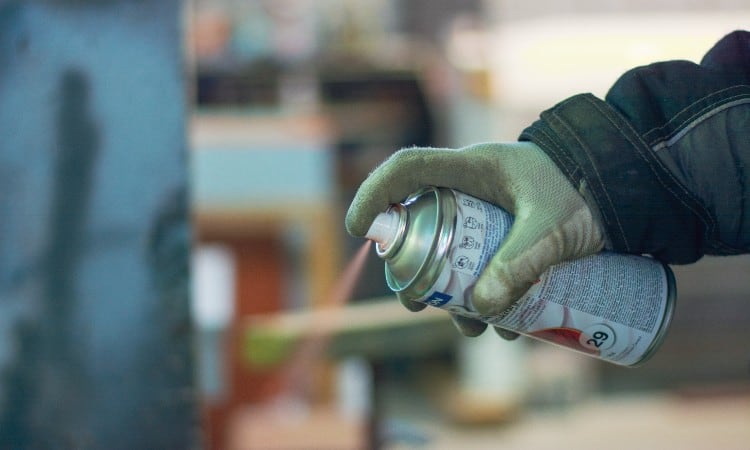How to Keep Spray Paint from Rubbing off
Have you ever had paint on your fingertips from touching a surface that had been spray painted? When using spray paint for a painting endeavor, this is typical. However, not all paints will rub off owing to certain factors. It is important to understand what spray paint is before talking about how to prevent rubbing off spray paints.
When you work so hard on a painting, and as soon as someone touches it, all your hard work starts to unravel.
How then can you prevent spray paint from coming off?
- Use the appropriate type of paint for the surface you’re painting to prevent spray paint from rubbing off. Before beginning to paint, make sure the surface is dry and clean.
- To make the paint adhere better, you can also use a primer. Use a clear sealer over the paint if you’re still experiencing issues. This will guard against it rubbing off.
- There are a couple of other methods you can try if you still have difficulties preventing paint from rubbing off. One is to combine some dish soap with your paint. This will improve the paint’s ability to stick to the surface.
- Attempt using a different kind of paint as well. Some paint varieties are more resilient to rubbing than others.
- Finally, you might try using a different primer or sealer if you still have issues. You can get the right finish with various products available on the market. Try different ones until you discover the one that suits you the best.

What Exactly Is “Spray Painting”?
Aerosol paint is another name for spray paint. It is a particular kind of paint that is kept in a container under pressure and is dispersed via a valve that lets out a mixture of paint and fuel, usually compressed air pressurized gas. The outcome is a fine, even mist that is applied to a variety of surfaces.
One of the three fundamental methods of applying paint is spray painting and using a paintbrush or roller. Generally, producing a uniform coat is quicker, cleaner, and more straightforward.
There are many names for these paints, including lacquer and enamel. Additionally, there are additives, binders, solvents, and pigments present. When applying paint, maintain a distance of 15-20 cm between the object and the sprayer.
Spray Paint Types
Popular spray paints include bitumen, nitrocellulose lacquers, and latex acrylic. Latex and acrylic are examples of water-based paints. Latex paint is less flexible than acrylic paint because latex paint lacks chemical components. Conversely, latex paints are more affordable than acrylic paints.
The spray tip of the aerosol is between 80 and 120 mesh. Some models or manufacturers offer greater mesh ranges, up to 220 mesh, for perfect details. This critical aspect about spray paint rubbing off must be kept in mind.
Spray paint applications
Spray paints come in a wide variety of textures and hues. They are appropriate for any DIY project, including canvas painting. Additionally, you can paint on paper, cardboard, fabric, wood, and plastic. The color of the paint varies depending on the use, such as in outdoor applications with natural light.
The most prevalent trait of these paints is that they are unsuited for producing a long-lasting or durable result.
Graffiti painting and creating murals are two distinct ways to employ spray paint.
What Leads to the Rub-Off of Spray Paints?
For a variety of reasons, your spray paint might come off. The nozzle’s grit size is the primary factor since smaller grit sizes cause particles to break apart more readily. It causes the paint to disperse and become airborne during the spraying process. A more extraordinary grit enables a more uniform finish and lowers the possibility of “paint mist.”
When lacquer is used instead of latex or acrylic paints, rubbing off is possible. However, the color might not be as flexible as these paints. As a result, as the weather changes, the paint could come off the surface.
Applying cheaper, lower-quality paint with too many fillers can also contribute to chipping and unwanted rubbing off spray paint.

Listed Below Are Some of the Most Common Spray Paint Mistakes:
How many mistakes can someone make with spray paint?
With spray paint, it’s frequently trial and error; occasionally, it doesn’t flow immediately. The majority of spray paint errors may be corrected and prevented, though. Read the following to discover the most effective techniques to avoid making any of these errors in the future;
Ventilation
One of the main issues with spray paint is a lack of or poor ventilation. For the greatest results on your DIY spray-painting project, spray your object in a well-ventilated location. Spray painting is frequently done outside, where a light breeze won’t affect how the paint flows as it leaves the nozzle.
You will need a gentle but consistent wind because many spray paints include solvents, which are dangerous to the body when ingested excessively. Additionally, you should put on the appropriate safety gear, such as a safety mask and a pair of protective gloves.
Lifting
The paint shrinks fades, or wrinkles if the drying times on the spray paint bottle are ignored, which results in lifting. This occurs when you spray paint anything without adequately preparing it or curing it first.
Remove the paint from the affected area, then sand it to cure lifting. One of the things you could require to help the spray paint adhere to the surface of the item is the use of a primer. After that, you must reapply paint or finish the desired area.
Ensure adequate time for drying between coats to prevent this from happening again. It may take some time to prepare the surface properly, but you shouldn’t rush it because doing so will only lead to long-term issues. Last but not least, be sure you use the right paint. Spray paint may be tempting since it is less expensive, but high-quality paint, such as RAL color aerosols, is preferable.
Expired Gloss Coats
Gloss finishes are a fantastic method for giving your product a sophisticated and refined appearance. Unfortunately, any finish may eventually become dull due to the climate and the coating’s age.
Spray paint is susceptible to premature dulling, frequently brought on by moisture. Any object or surface spray painted in a moist or humid atmosphere may lose some of its gloss. If anything needs to be polished, such a metal, doing it too soon can impair how glossy it stays. An inadequately cleaned surface with dirt or dust particles on it may not seem as good. avoid using very old or expired spray paint to keep the paint shine and durability in perfect condition.
Peeling or flaking
Peeling results when the primer, topcoat, or basecoat is sprayed but does not adhere well. As a result, numerous paint layers separate and peel off one another. Peeling seems to occur frequently when the surface is improperly prepared. Most people don’t fully clean the surface after sanding or after preparation.
Since it won’t be able to make touch with the substrate if you don’t do this, the coating might not stick to the surface. In order to prevent it from happening again, we often advise removing a section just slightly larger than the damaged zone back to the bare substrate.
Allow the paint to completely dry.
Even though spray paint is among the quickest and simplest ways to paint a surface, it can be not very pleasant when the colour begins to wipe off as soon as you use it.
This might occur because the paint isn’t fully dried, in which case you’ll need to wait for it to dry before moving on to other tasks.
By touching the paint, you can check to see if it’s dry; if it still feels damp, it probably isn’t.
How Can I Prevent Rubbing Spray Paint Off?
Use these guidelines to stop spray paint from rubbing off:
- With water-based acrylic or latex paints, use finer spray tips.
- Where temperatures vary widely, pick aerosol spray cans with more propellants.
- To prevent lacquer coatings within the spray can, keep it at room temperature.
- For improved adhesion, use primer before spray painting.
- To guarantee that the paint stays on the surface, give the paints between 24 and 48 hours to dry completely.
- paint when the weather is in favorable condition for painting. Spray paints should never be used in extreme heat or cold.
- make use of spray paint hvlp machine for large surfaces to get even coating on sides and consistent sheen on surface.

Ascertain the paint’s appropriate thickness. Use caution when applying very little or thin paint.
By eliminating cracks and water absorption, a primer will aid in the protection of the spray paint.
Spray cans shouldn’t be stored in a fridge. If stored in such a way, lacquer coatings may form inside the aerosol. It could produce clumpy or gritty results.
Final Reflections
There is no cause for concern regarding the peeling of spray paint. To increase the paints’ adherence:
Follow the directions above.
Choose the correct grit size of the nozzle, use latex or acrylic paints, and apply primer first, followed by spray paint.
Do not rush when painting; instead, allow plenty of time to dry.

Being associated with art and craft field since decades as a hobbyist and life long learner has given me an opportunity to learn many new things related to art, craft, paints and pottery which i am trying to share with your guys on this website. I have expertise of being professional painter and potter for the last 20+ years
I have learned mind blowing cool tips and insights which makes me a person with ability to improvise and come up with creative ideas and solutions to make stunning and impeccable art pieces of all types which are adored by people across the globe on this website and other platform.


